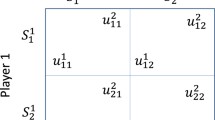Abstract
In this paper, we analyse a variation of truel competitions in which each prospective player is represented by a node in a scale-free network. Without including any particular spatial arrangement of players, traditional game theory suggests that in many truel settings the strongest player often has the lowest probability of survival, a paradox that has been popularised by the term survival of the unfittest. However, both our single-run and the Monte-Carlo simulations suggest that this particular notion does not hold in scale-free networks. The spatial structure and arrangement of players are crucial for the outcome of truels, as in scale-free networks the number of players surviving the competition positively depends on their marksmanship (i.e., the strongest players indeed have the highest probability of survival).





Similar content being viewed by others
Notes
For a later summary of his results, also see Kilgour and Brams (1997).
References
Albert R, Jeong H, Barabási A-L (1999) Internet: diameter of the world-wide web. Nature 401(6749):130–131
Almaas E, Vazquez A, Barabasi A-L (2007) Scale-free networks in biology. Biol Netw 1–19
Amengual P, Toral R (2006) Truels, or survival of the weakest. Comput Sci Eng 8(5):88–95
Archetti M (2012) Survival of the weakest in n-person duels and the maintenance of variation under constant selection. Evolution 66(3):637–650
Barabási A-L, Albert R (1999) Emergence of scaling in random networks. Science 286(5439):509–512
Barabási A-L, Oltvai ZN (2004) Network biology: understanding the cell’s functional organization. Nat Rev Genet 5(2):101–113
Dorraki M, Allison A, Abbott D (2019) Truels and strategies for survival. Sci Rep 9:8996
Ebel H, Mielsch L-I, Bornholdt S (2002) Scale-free topology of e-mail networks. Phys Rev E 66:035103
Gardner M (1966) New mathematical puzzles and diversions. London
Jackson MO, Rogers BW (2007) Meeting strangers and friends of friends: How random are social networks? Am Econ Rev 97(3):890–915
Kilgour DM (1972) The simultaneous truel. Int J Game Theory 1(4):229–242
Kilgour DM (1975) The sequential truel. Int J Game Theory 4(3):151–171
Kilgour DM (1978) Equilibrium points of infinite sequential truels. Int J Game Theory 6(3):167–180
Kilgour DM, Brams SJ (1997) The truel. Math Mag 70(5):315–326
Kinnaird C (1946) Encyclopedia of puzzles and pastimes. Citadel, Secaucus
Larson HD, Moser L (1948) A dart game. Am Math Mon 55(10):640–641
Mele A (2018) A structural model of homophily and clustering in social networks. Conference on network science in economics
Toral R, Amengual P (2005) Distribution of winners in truel games. AIP Conf Proc 779(1):128–141
Wang XF, Chen G (2003) Complex networks: small-world, scale-free and beyond. IEEE Circuits Syst Mag 3(1):6–20
Watts DJ, Strogatz SH (1998) Collective dynamics of ‘small-world’ networks. Nature 393:440–442
Xu X (2012) Game of the truel. Synthese 185:349–355
Author information
Authors and Affiliations
Corresponding author
Additional information
Publisher's Note
Springer Nature remains neutral with regard to jurisdictional claims in published maps and institutional affiliations.
Rights and permissions
About this article
Cite this article
Wegener, M., Mutlu, E. The good, the bad, the well-connected. Int J Game Theory 50, 759–771 (2021). https://doi.org/10.1007/s00182-021-00765-1
Accepted:
Published:
Issue Date:
DOI: https://doi.org/10.1007/s00182-021-00765-1




